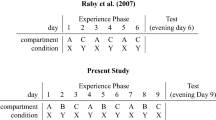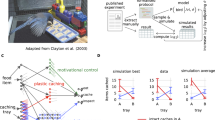Abstract
According to the 'mental time travel hypothesis' animals, unlike humans, cannot mentally travel backwards in time to recollect specific past events (episodic memory) or forwards to anticipate future needs (future planning). Until recently, there was little evidence in animals for either ability. Experiments on memory in food-caching birds, however, question this assumption by showing that western scrub-jays form integrated, flexible, trial-unique memories of what they hid, where and when. Moreover, these birds can adjust their caching behaviour in anticipation of future needs. We suggest that some animals have elements of both episodic-like memory and future planning.
This is a preview of subscription content, access via your institution
Access options
Subscribe to this journal
Receive 12 print issues and online access
$189.00 per year
only $15.75 per issue
Buy this article
- Purchase on Springer Link
- Instant access to full article PDF
Prices may be subject to local taxes which are calculated during checkout



Similar content being viewed by others
References
Larson, G. A Far Side Collection. The Chickens are Restless (FarWorks Inc., Missouri, 1993).
Hazlitt, W. An Essay on the Principles of Human Action (J. Johnson, London, 1805).
Köhler, W. The Mentality of Apes (Routledge & Kegan Paul, London) (Translated by E. Winter in 1927, original work published in 1917).
Bischof, N. in Morality as a Biological Phenomenon (ed. Stent, G.) 53–74 (Abakon, Berlin, 1978).
Bischof-Köhler, D. in Emotion und Reflexivität (eds Eckensberger, L. H. & Lantermann, E. D.) 3–47 (Urban & Schwarzenberg, Vienna, 1985).
Tulving, E. Memory and consciousness. Can. Psychol. 26, 1–12 (1985).
Suddendorf, T., & Corballis, M. C. Mental time travel and the evolution of the human mind. Genet. Soc. Gen. Psychol. Monogr. 123, 133–167 (1997).
Tulving, E. in Organisation of Memory (eds Tulving, E. & Donaldson, W) 381–403 (Academic, San Diego, California, 1972).
Perner, J. Understanding the Representational Mind (MIT Press, Cambridge, Massachusetts, 1991).
Perner, J. in The Self In Time: Developmental Perspectives (eds Moore, C. & Lemmon, K.) 181–202 (Lawrence Erlbaum, New Jersey, 2001).
McCormack, T. & Hoerl, C. Memory and temporal perspective: the role of temporal frameworks in memory development. Dev. Rev. 19, 154–182 (1999).
McCormack, T. & Hoerl, C. in The Self in Time: Developmental Perspectives (eds Moore, C. & Lemmon, K.) 203–227 (Lawrence Erlbaum, New Jersey, 2001).
Gallistel, C. R. The Organization of Learning (MIT Press, Cambridge, Massachusetts, 1990).
Friedman, W. J. Memory for the time of past events. Psychol. Bull. 113, 44–66 (1993).
Tulving, E. in Principles of Frontal Lobe Function (eds Stuss, D. T. & Knight, R. C.) 311–325 (Oxford Univ. Press, New York, 2002).
Wheeler, M. A. in The Oxford Handbook of Memory (eds Tulving, E. & Craik, F. I. M.) 597–625 (Oxford Univ. Press, Oxford, 2000).
Corkin, S. What's new with the amnesic patient H. M.? Nature Rev. Neurosci. 3, 153–160 (2002).
Roberts, W. A. Are animals stuck in time? Psychol. Bull. 128, 473–489 (2002).
Tulving, E. Elements of Episodic Memory (Clarendon, Oxford, 1983).
Tulving, E. & Markowitsch, H. J. Episodic and declarative memory: role of the hippocampus. Hippocampus 8, 198–204 (1998).
Griffiths, D. P., Dickinson, A. & Clayton, N. S. Declarative and episodic memory: what can animals remember about their past? Trends Cogn. Sci. 3, 74–80 (1999).
Schwarz, B. L. & Evans, S. Episodic memory in primates. Am. J. Primatol. 55, 71–85 (2001).
Gaffan, D. Amnesia for complex naturalistic scenes and for objects following fornix transection in the rhesus monkey. Eur. J. Neurosci. 4, 381–388 (1992).
Zola-Morgan, S., Squire, L. R. & Ramus, S. Severity of memory impairment in monkeys as a function of locus and extent of damage within the medial temporal lobe memory system. Hippocampus 4, 483–495 (1994).
Morris, R. G. M. Episodic-like memory in animals: psychological criteria, neural mechanisms and the value of episodic-like tasks to investigate animal models of neurodegenerative disease. Phil. Trans. R. Soc. Lond. 356, 1453–1466 (2001).
Zentall, T. R., Clement, T. S., Bhatt, R. S. & Allen, J. Episodic-like memory in pigeons. Psychonom. Bull. Rev. 8, 685–690 (2001).
Schwarz, B. L., Colon, M. R., Sanchez, I. C., Rodriguez, I. A. & Evans, S. Single-trial learning of 'what' and 'who' information in a gorilla (Gorilla gorilla gorilla): implications for episodic memory. Anim. Cogn. 5, 85–90 (2002).
Mandler, G. Recognising: the judgement of previous experience. Psychol. Rev. 87, 252–271 (1980).
Jacoby, L. L. & Dallas, M. On the relationship between autobiographical memory and perceptual learning. J Exp Psychol Gen. 110, 306–340 (1981).
Jacoby, L. L. A process dissociation framework: separating automatic from intentional uses of memory. J. Mem. Lang. 30, 513–541 (1991).
Aggleton, J. P. & Brown, M. W. Episodic memory, amnesia and the hippocampal-anterior thalamic axis. Behav. Brain Sci. 22, 425–444 (1999).
Henson, R. N. A., Rugg, M. D., Shallice, T., Josephs, O. & Dolan, R. J. Recollection and familiarity in recognition memory: an event-related functional magnetic resonance imaging study. J. Neurosci. 19, 3962–3972 (1999).
Yonelinas, A. P. Components of episodic memory and autonoetic consciousness: the contribution of recollection and familiarity. Phil. Trans. R. Soc. Lond. 356, 1363–1374 (2001).
Yonelinas, A. P. et al. Effects of extensive temporal lobe damage or mild hypoxia on recollection and familiarity. Nature Neurosci. 5, 1236–1241 (2002).
Metcalfe, J., Cottrell, G. W. & Menzel, W. E. Cognitive binding: a computational-modeling analysis of the distinction between explicit and implicit memory. J. Cogn. Neurosci. 4, 289–298 (1992).
Squire, L. R., Knowlton, B. & Musen, G. The structure and organization of memory. Annu. Rev. Psychol. 44, 453–496 (1993).
Schacter, D. L., Chiu, C. Y. & Ochsner, K. N. Implicit memory: a selective review. Annu. Rev. Neurosci. 16, 159–182 (1993).
Eichenbaum, H. & Cohen, N. J. From Conditioning to Conscious Recollection. Memory Systems of the Brain (Oxford Univ. Press, Oxford, 2001).
Cohen, N. J. in The Neuropsychology of Memory (eds Butters, N. & Squire, L. R.) 83–103 (Guilford, New York, 1984).
Mishkin, M. & Delacour, J. An analysis of short-term visual memory in the monkey. J. Exp. Psychol. Anim. Behav. Proc. 1, 326–334 (1975).
Steele, R. J. & Morris, R. G. M. Delay-dependent impairment of a hippocampal-dependent matching to place task with chronic and intrahippocampal infusion of the NMDA antagonist D-AP5. Hippocampus 9, 118–136 (1999).
Fortin, N. J., Agster, K. & Eichenbaum, H. B. Critical role of the hippocampus in memory for sequences of events. Nature Neurosci. 5, 458–562 (2002).
Menzel, C. R. Unprompted recall and reporting of hidden objects by a chimpanzee (Pan troglodytes) after extended delays. J Comp Psychol. 113, 426–434 (1999).
Day, M., Langston, R. & Morris, R. G. M. Glutamate-receptor-mediated encoding and retrieval of paired-associate learning. Nature 424, 205–209 (2003).
Winocur, G. & Weiskranz, L. An investigation of paired-associate learning in amnesic patients. Neuropsychologia 14, 97–110 (1976).
Shallice, T. et al. Brain regions associated with acquisition and retrieval of verbal episodic memory. Nature 368, 633–635 (1994).
Dudai, Y. Memory from A to Z. Keywords, Concepts and Beyond (Oxford Univ. Press, Oxford, 2002).
Clayton, N. S. & Dickinson, A. Episodic-like memory during cache recovery by scrub jays. Nature 395, 272–278 (1998).
Clayton, N. S. & Dickinson, A. Scrub Jays (Aphelocoma coerulescens) remember the relative time of caching as well as the location and content of their caches. J. Comp. Psychol. 113, 403–416 (1999).
Clayton, N. S., Yu, K. & Dickinson, A. Scrub jays (Aphelocoma coerulescens) can form integrated memory for multiple features of caching episodes. J. Exp. Psychol. Anim. Behav. Proc. 27, 17–29 (2001).
McCormack, T. in Time and Memory. Issues in Philosophy and Psychology (eds McCormack, T. & Hoerl, C.) 285–314 (Clarendon, Oxford, 2001).
Clayton, N. S., Yu, K. S. & Dickinson, A. Interacting cache memories: evidence of flexible memory use by scrub jays. J. Exp. Psychol. Anim. Behav. Proc. 29, 14–22 (2003).
Milton, K. Distribution patterns of tropical plant foods as an evolutionary stimulus to primate mental development. Am. Anthropol. 83, 534–548 (1981).
Suddendorf, T. Discovery of the Fourth Dimension: Mental Time Travel and Human Evolution. M.Sc. thesis, Univ. Waikato, Auckland, New Zealand (1994).
Berthold, P., Heilbig, A. J., Mohr, G. & Querner, U. Rapid microevolution of migratory behaviour in a wild bird species. Nature 360, 668–670 (1992).
Moss, C. Echo of the Elephants (BBC Books, London, 1992).
Attance, C. & O'Neill, D. K. Episodic future thinking. Trends Cogn. Sci. 5, 533–539 (2001).
Boesch, C. & Boesch, H. Mental map in wild chimpanzees: an analysis of hammer transports for nut cracking. Primates 25, 160–170 (1984).
Byrne, R. The Thinking Ape. Evolutionary Origins of Intelligence (Oxford Univ. Press, Oxford, 1995).
Emery, N. J. & Clayton, N. S. Effects of experience and social context on prospective caching strategies in scrub jays. Nature 414, 443–446 (2001).
Acknowledgements
This research was supported by grants from the National Institutes of Health and the Grindley Trust to N.S.C. and a BBSRC grant to N.S.C. and A.D., and conducted within a UK Medical Research Council Cooperative Grant. We thank S. de Kort, N. Emery, R. Morris and T. Robbins for comments and discussion. Special thanks go to N. Emery for his original artwork, and to I. Cannell for his photographic skills.
Author information
Authors and Affiliations
Corresponding author
Related links
Rights and permissions
About this article
Cite this article
Clayton, N., Bussey, T. & Dickinson, A. Can animals recall the past and plan for the future?. Nat Rev Neurosci 4, 685–691 (2003). https://doi.org/10.1038/nrn1180
Issue Date:
DOI: https://doi.org/10.1038/nrn1180
This article is cited by
-
Inheritance of associative memories and acquired cellular changes in C. elegans
Nature Communications (2023)
-
Plans, Open Future and the Prospects for a Good Life
Ethical Theory and Moral Practice (2023)
-
Why it hurts: with freedom comes the biological need for pain
Animal Cognition (2023)
-
Rats use strategies to make object choices in spontaneous object recognition tasks
Scientific Reports (2022)
-
Higher Cognitive Abilities in Birds: A Comparative Evolutionary Analysis
Neuroscience and Behavioral Physiology (2022)



